AI detection provides many benefits for those who need it. For you, who just want to utilize AI content writing tools, AI detection softwares aren't helping. In this article, we'll explain how to bypass AI detection using AI Bypass. This software is so skilled at rephrasing text that no AI detector, including our own AI Detect, can tell when text has been rewritten by AI Bypass. Eager to find out how to outsmart AI detection with AI Bypass? Let's dive in.
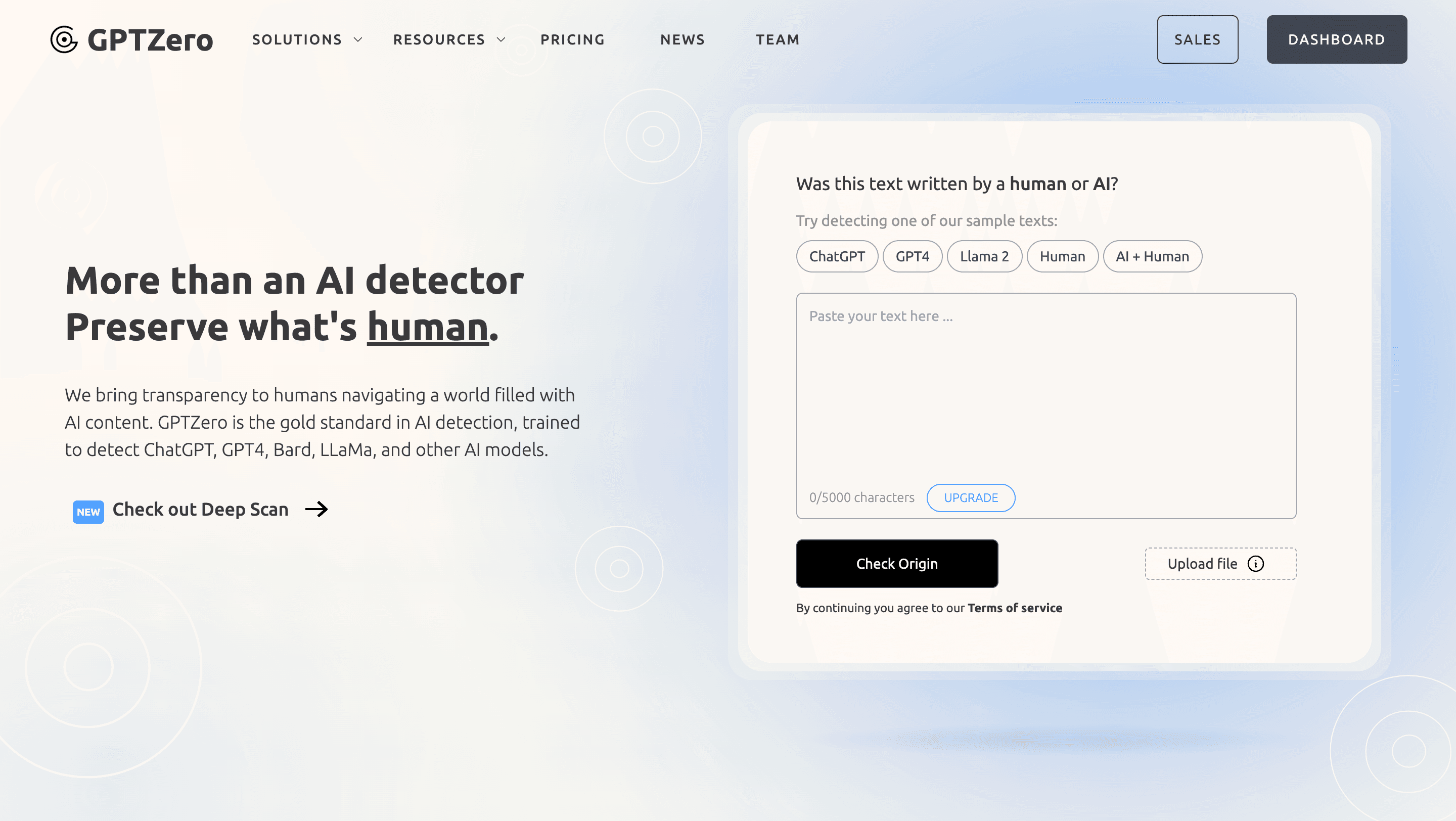 AI detection is the process through which the usage of AI software in content creation is identified. This process is carried out by AI detectors. During AI detection, the AI detector first collects the text that is to be analyzed. Then, it checks for particular patterns of writing that are common to AI content writing tools. It also sieves out sentences that sound as if they were generated by AI.
AI detection is the process through which the usage of AI software in content creation is identified. This process is carried out by AI detectors. During AI detection, the AI detector first collects the text that is to be analyzed. Then, it checks for particular patterns of writing that are common to AI content writing tools. It also sieves out sentences that sound as if they were generated by AI.
When training an AI detection software, the developers usually create plenty of text using AI content writing tools. Then, they'll “feed” this text into the software to help it understand the nature of AI-written content. However, developers hardly train AI content detectors with content created by every AI content generator out there.
Hence, an AI detector may be able to correctly predict that text generated by tool A was AI-written, but may not be able to tell that text generated by tool B was written by AI. The probable cause of this is that the AI content detector was trained with text produced by tool A but not tool B.
That said, an AI detection software usually works by identifying if each part of a block of text was written by AI or humans. It then puts content that appears to have been written by a human into a “bag,” and then puts the content that appears AI-generated into another “bag.”
When displaying the results of AI detection to the user, the software expresses the quantity of the content that appears to have been created with AI as a percentage of the entire content. For example, if half of the text appeared to have been created with AI, the AI detection tool may state that 50% of the text is likely to have been AI-generated.
The use of the phrase “likely” in displaying the analysis results indicates that AI content checkers weigh the amount of AI text in a piece of content on a balance of probabilities. In other words, AI content detectors don't actually tell you if an AI tool or a human wrote something. But, they give you the odds on whether the content was human or AI-written. If they say that text contains 60% AI content, it means that there's a 60% chance that the text was generated with the help of AI and a 40% chance that it was written entirely by a human.
Now that you understand how AI content detectors work, let's examine the processes employed by these AI detection tools.
We've been taught to mix up words every now and then while writing. The way in which humans write is similar to how we talk — it makes sense, it's logical, and it uses subtleties that AI can't really replicate. For example, when telling a story, a human is likely to start at point A, veer off to point B to point out something, and then come back to point A to continue the storytelling arc.
However, AI content writing tools go straight from point A to the last point, never for once veering out of course. This nearly-perfect manner of writing is one of the things that AI content detection tools watch out for during AI detection.
The analysis of word usage also involves appraising the perplexity and burstiness of text. These two terms were actually first used by GPT Zero in explaining how their AI detection tool works. What do they really mean? We'll shed more light on them below.
While “reading” each word in the text, the AI detection platform attempts to guess the word that'll come after that word. The more the number of correct guesses it makes, the lower the perplexity of the text.
Text with low perplexity is usually flagged as content written by AI. Meanwhile, when text has high perplexity, it's more likely to have been written by a human.
AI content writing platforms usually struggle with varying the length and complexity of sentences. Therefore, text containing sentences that are almost the same length and are equally difficult or easy to understand is usually deemed to have been written by AI.
Each AI detection software above has its strengths and weaknesses. But none of them is strong enough to correctly identify text that was generated by AI Bypass.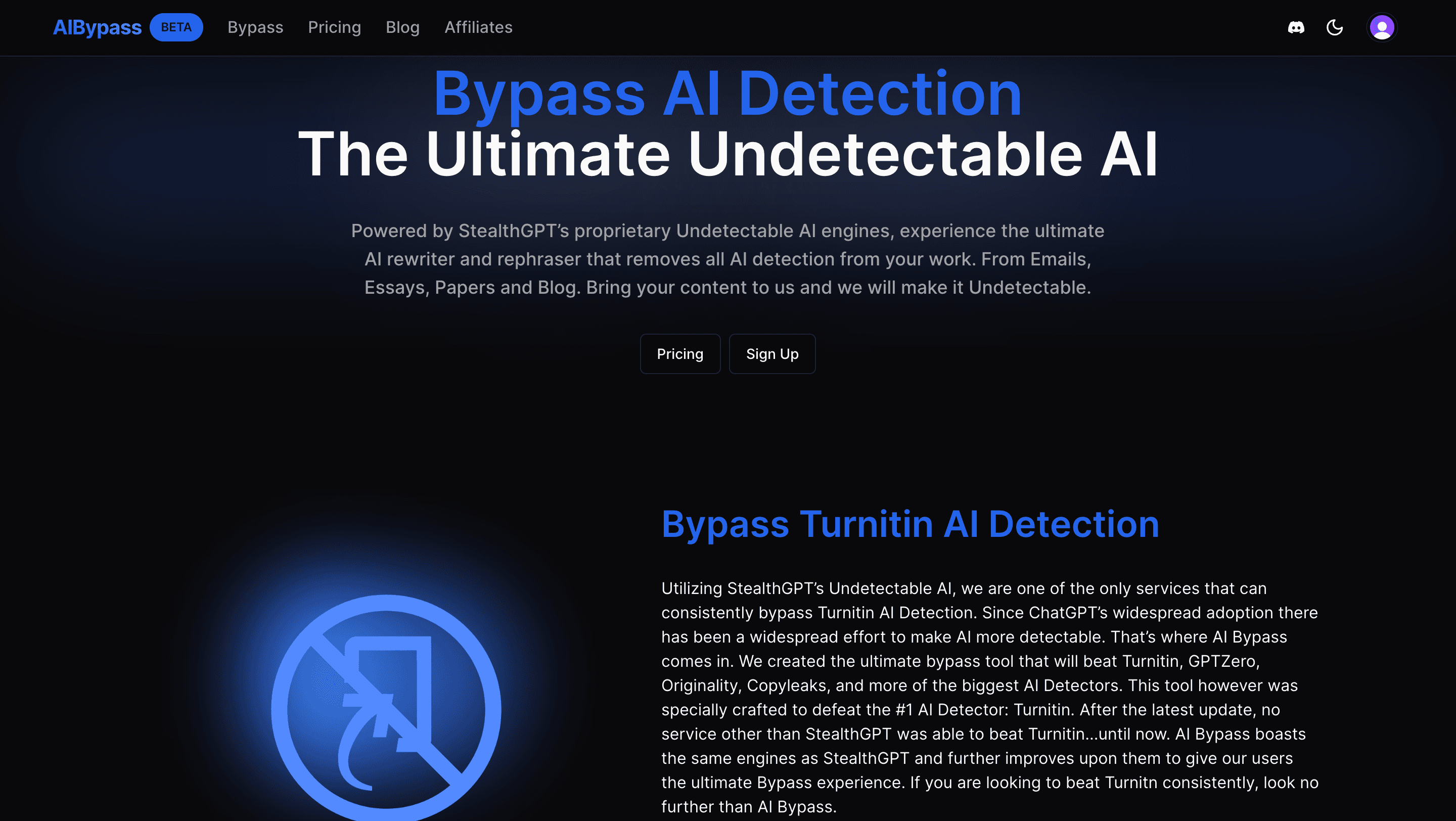 AI Bypass is an escape route for anyone who wants to utilize AI in the content writing process without being caught. Its primary goal is to work around AI-written content so that even the best AI detection tools, including Turnitin, will be unable to detect that the content was generated by artificial intelligence. AI Bypass is modeled after and powered by StealthGPT's undetectable AI.
AI Bypass is an escape route for anyone who wants to utilize AI in the content writing process without being caught. Its primary goal is to work around AI-written content so that even the best AI detection tools, including Turnitin, will be unable to detect that the content was generated by artificial intelligence. AI Bypass is modeled after and powered by StealthGPT's undetectable AI.
StealthGPT is the only software that's capable of rephrasing content in a manner that fools even Turnitin. With an active AI Bypass account, you won't fear that any tool will detect that you've used AI in creating content. Thus, you can freely generate as much content as you want with AI.
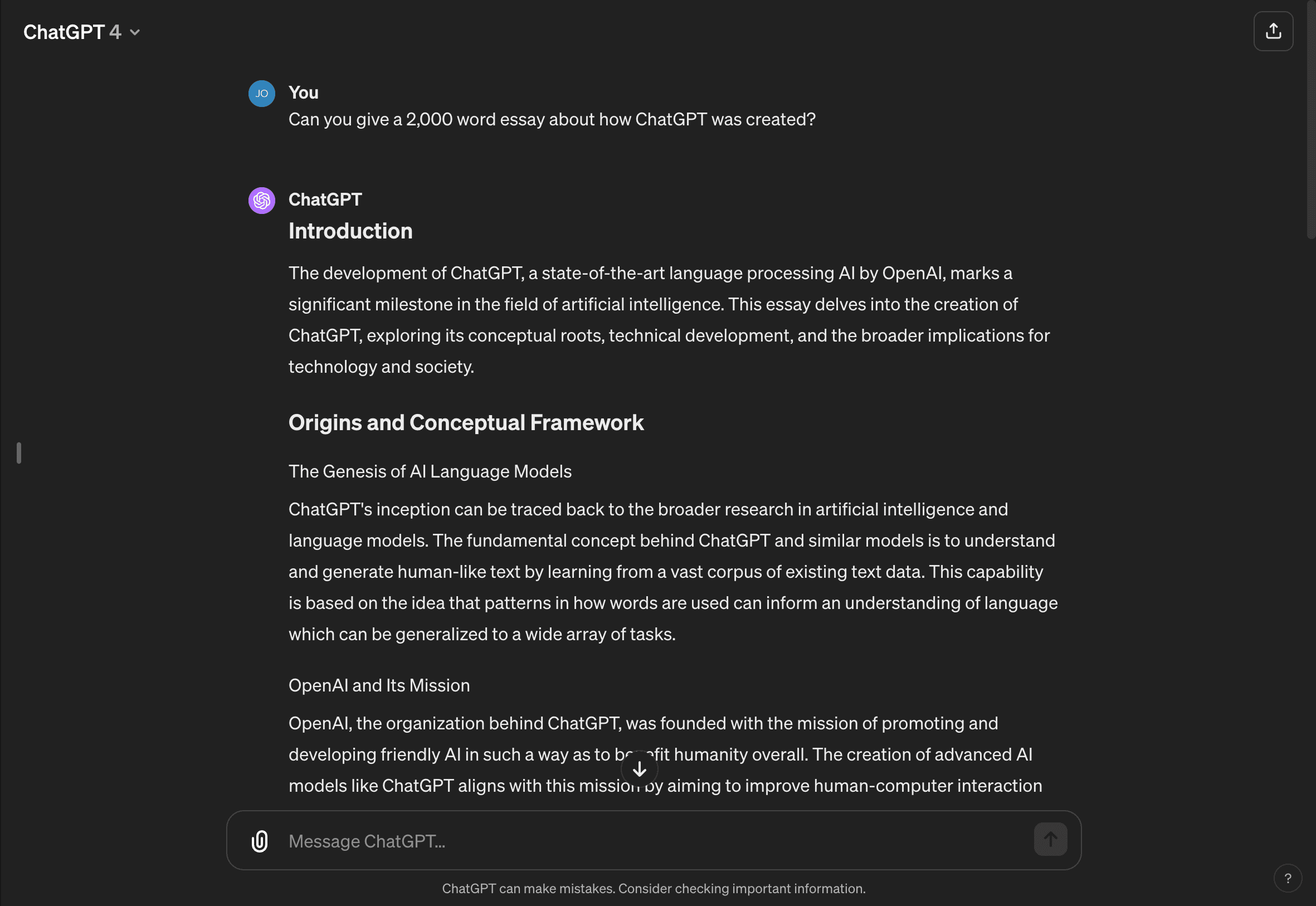 The first step is to create some content with any AI tool that you have access to. It could be ChatGPT, Copy.ai, Jasper, or any other software. Use any prompt you want. For the purpose of this article, we'll use ChatGPT to create an essay on how ChatGPT was created.
The first step is to create some content with any AI tool that you have access to. It could be ChatGPT, Copy.ai, Jasper, or any other software. Use any prompt you want. For the purpose of this article, we'll use ChatGPT to create an essay on how ChatGPT was created.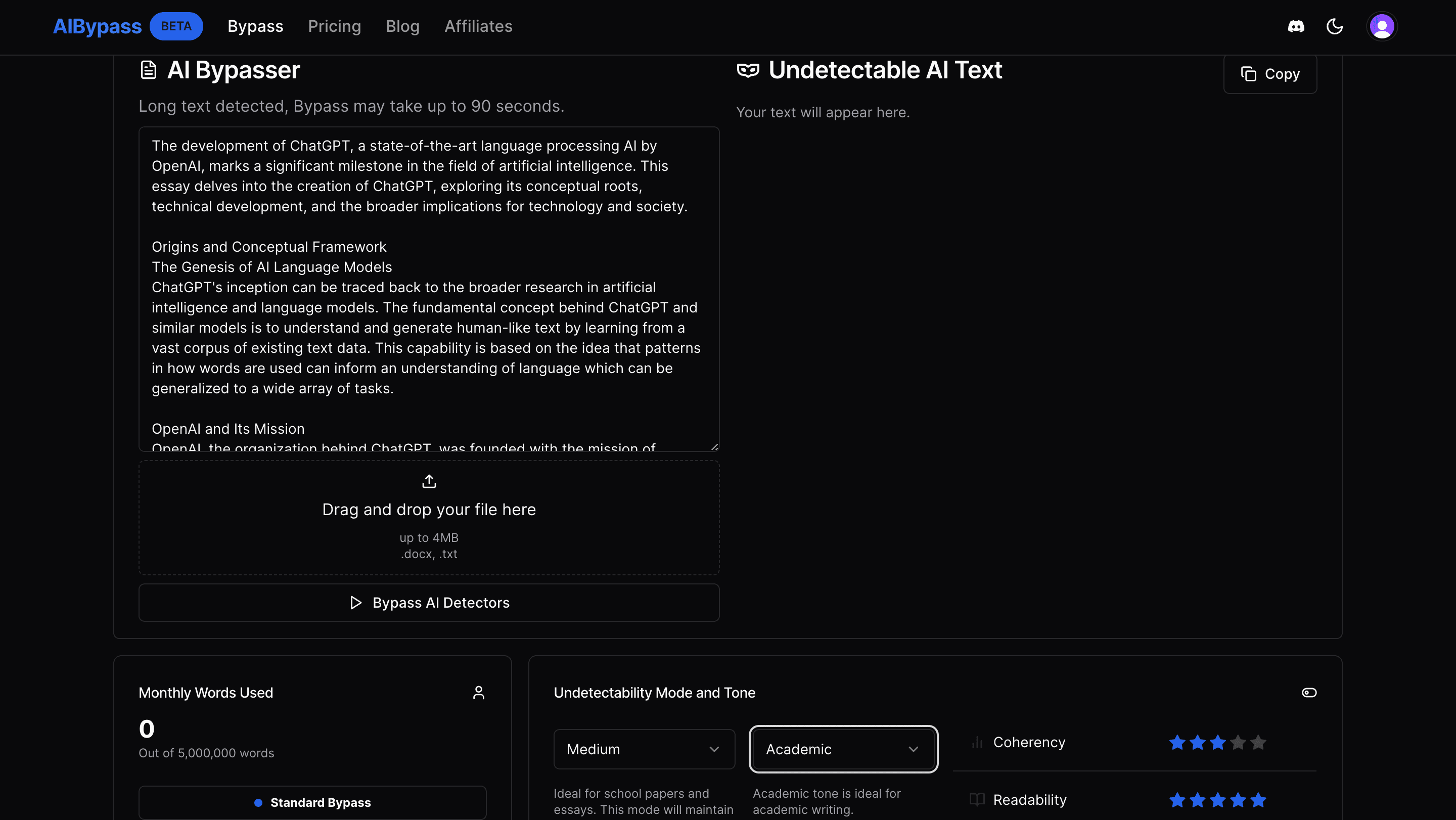 You don't need to edit the content before pasting it in AI Bypass. Just paste it the way it is.
You don't need to edit the content before pasting it in AI Bypass. Just paste it the way it is.
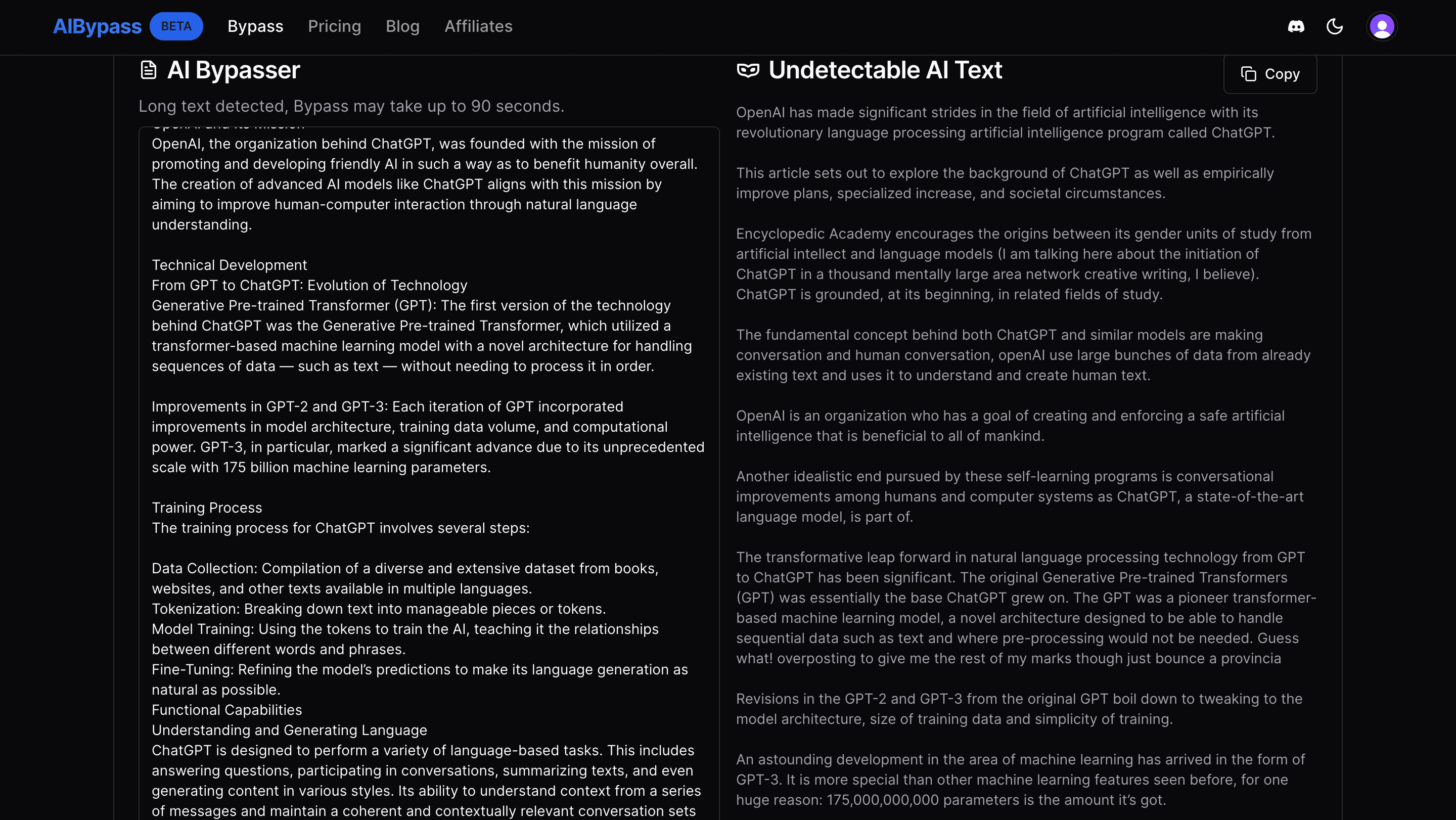 Upon a close examination of the undetectable AI text generated by AI Bypass, you'll find that AI Bypass uses a strategy that frustrates the processes that most AI detection software use for detecting AI content.
Upon a close examination of the undetectable AI text generated by AI Bypass, you'll find that AI Bypass uses a strategy that frustrates the processes that most AI detection software use for detecting AI content.
For example, in the third paragraph, it breaks the flow of thought in the essay. It restores this flow in the fourth paragraph. Paragraph 4 sounds exactly like a human would when talking. Also, fifth and ninth paragraphs effectively disrupt the essay's structure.
Here and there, you may observe a few typos. All these features are characteristic of human-written content before it's edited.
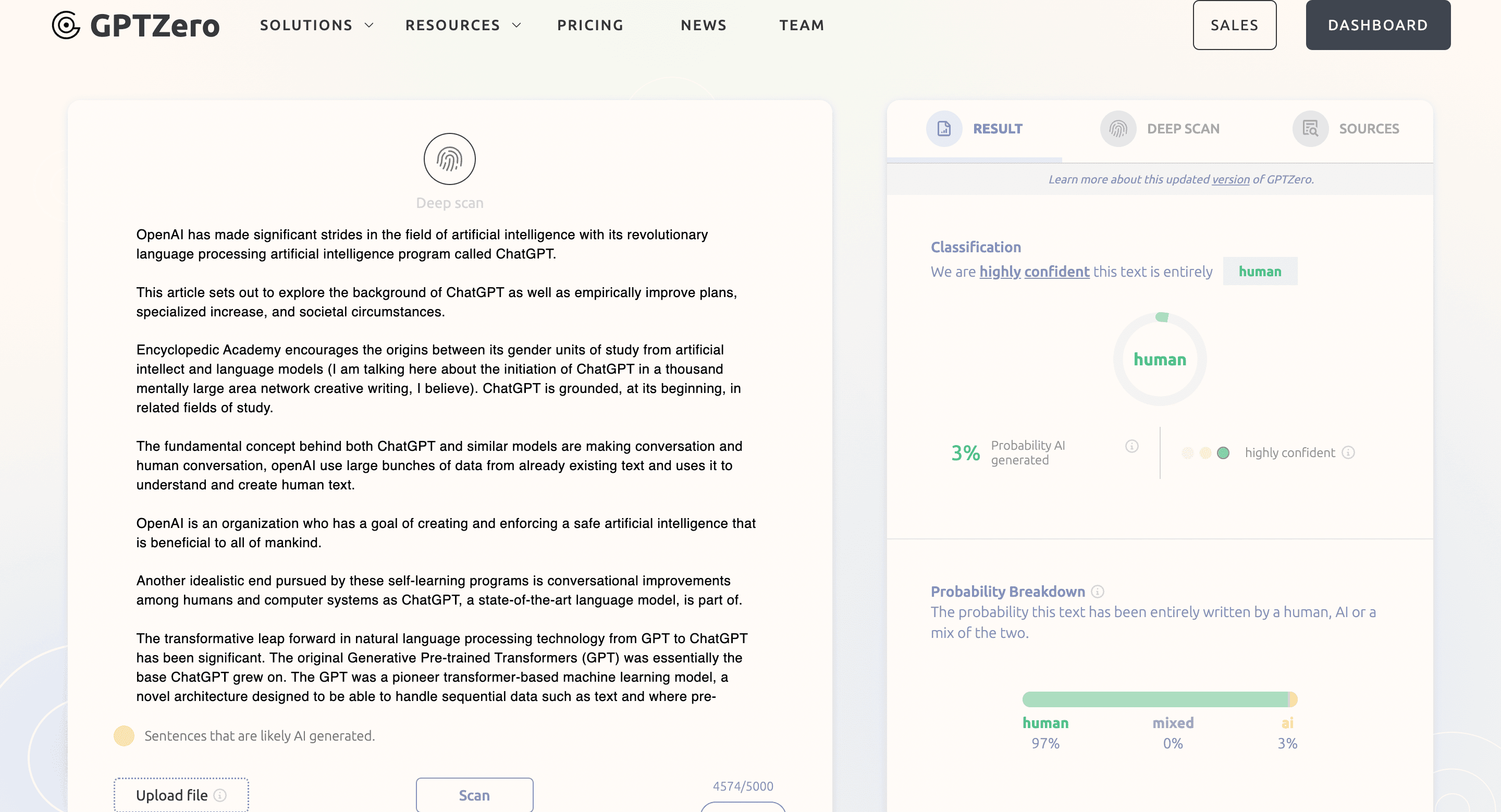 When GPTZero was first launched, it yielded many inaccurate results. Between then and now, it has been updated several times to improve its accuracy. Surprisingly, it still can't counter the abilities of AI Bypass. After GPT Zero scans the undetectable AI text, GPTZero believes that there's a 97% chance that the text has been written by a human. This implies that AI Bypass can bypass GPTZero completely.
When GPTZero was first launched, it yielded many inaccurate results. Between then and now, it has been updated several times to improve its accuracy. Surprisingly, it still can't counter the abilities of AI Bypass. After GPT Zero scans the undetectable AI text, GPTZero believes that there's a 97% chance that the text has been written by a human. This implies that AI Bypass can bypass GPTZero completely.
And here's a screenshot of the content's AI score on Originality.ai: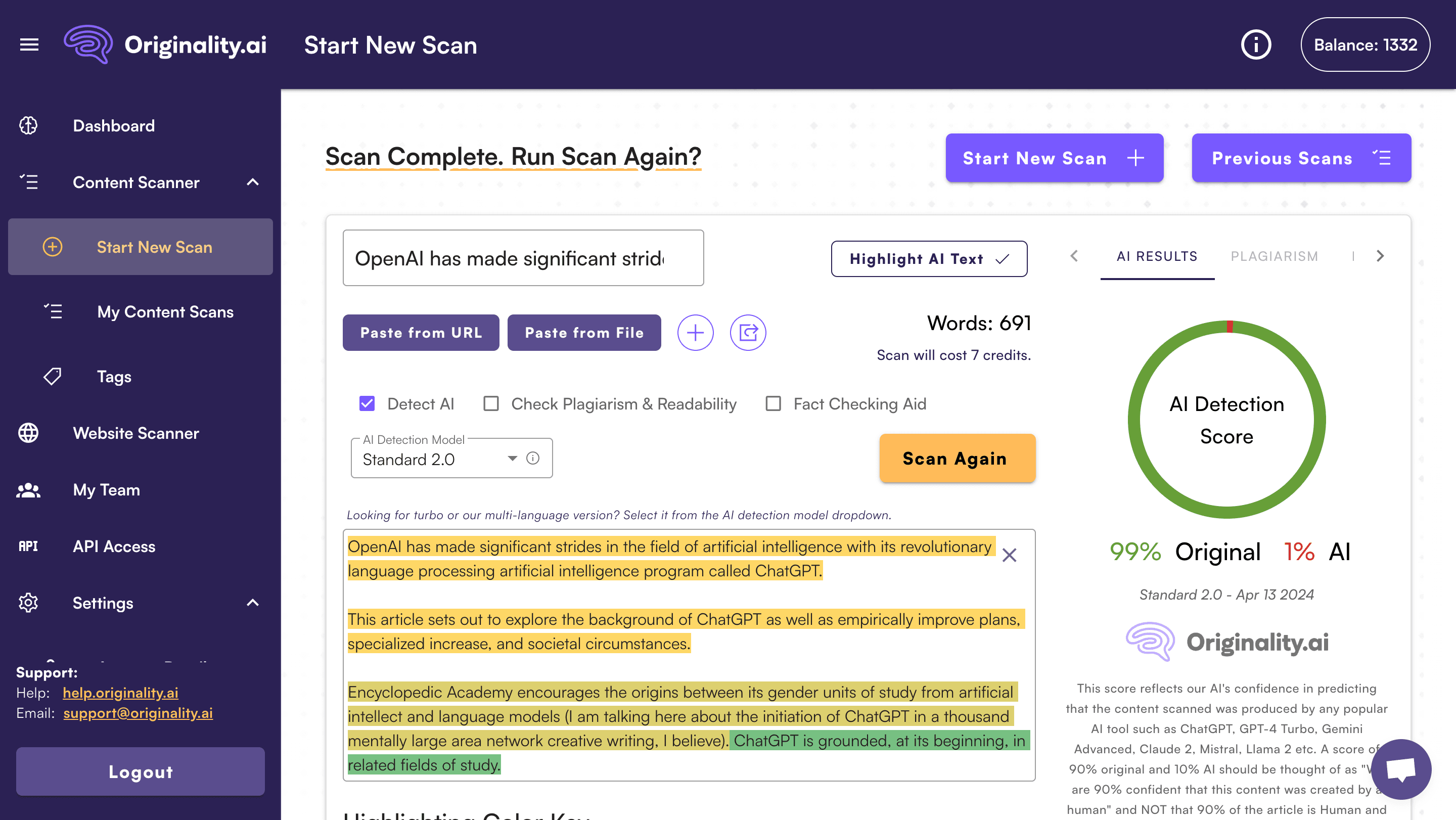 Originality.ai is among the most impressive. However, from the screenshot above, it's clear that Originality.ai, despite its sky-high quality, can't not detect that text rewritten by an AI software. The results of the scan show that Originality.ai thinks that there's a 99% chance our undetectable AI text has been written by a human. Apparently, AI Bypass can totally bypass Originality.ai as well.
Originality.ai is among the most impressive. However, from the screenshot above, it's clear that Originality.ai, despite its sky-high quality, can't not detect that text rewritten by an AI software. The results of the scan show that Originality.ai thinks that there's a 99% chance our undetectable AI text has been written by a human. Apparently, AI Bypass can totally bypass Originality.ai as well.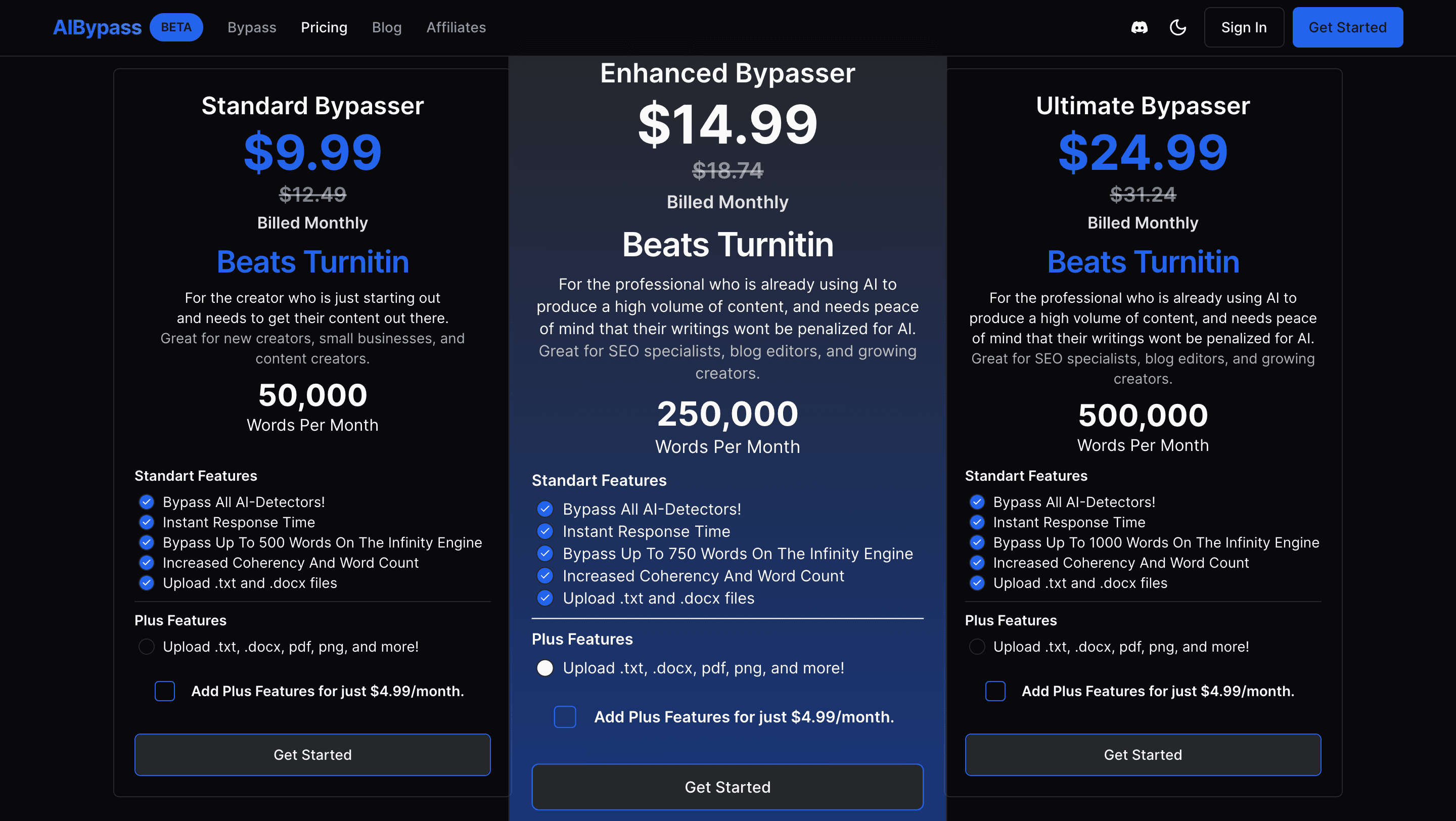 Each month, users pay a fixed price to access AI Bypass's services. Each subscription plan grants you access to rewriting content with AI Bypasser. After the content has been rewritten,its word count is usually higher and it becomes more coherent.
Each month, users pay a fixed price to access AI Bypass's services. Each subscription plan grants you access to rewriting content with AI Bypasser. After the content has been rewritten,its word count is usually higher and it becomes more coherent.
However, the number of words that you can rewrite with AI Bypass varies with the subscription plan you choose. Below is a summary of the subscription plans and how much work they help you do per month.
AI detection is a simple term for a complicated, highly technical procedure that AI content detectors use to pinpoint content written by AI. If AI detection softwares have been getting in your way, you need a weapon to fight them back. That weapon is AI Bypass. It's astonishingly excellent at humanizing AI-written content, and it never fails to bypass AI detection software, including our AI Detect. Sign up to AI Bypass for free now.
What Is AI Detection?

How Do AI Content Detectors Work?
AI content detectors actually use different procedures for AI detection, depending on how they were trained and the data that was used to train them. Generally, AI content detectors are trained to distinguish between AI content and human content by “digesting” large GBs of text written by humans and texts written by AI. The quality of AI content on which an AI content checker is trained affects the accuracy of its AI detection.When training an AI detection software, the developers usually create plenty of text using AI content writing tools. Then, they'll “feed” this text into the software to help it understand the nature of AI-written content. However, developers hardly train AI content detectors with content created by every AI content generator out there.
Hence, an AI detector may be able to correctly predict that text generated by tool A was AI-written, but may not be able to tell that text generated by tool B was written by AI. The probable cause of this is that the AI content detector was trained with text produced by tool A but not tool B.
That said, an AI detection software usually works by identifying if each part of a block of text was written by AI or humans. It then puts content that appears to have been written by a human into a “bag,” and then puts the content that appears AI-generated into another “bag.”
When displaying the results of AI detection to the user, the software expresses the quantity of the content that appears to have been created with AI as a percentage of the entire content. For example, if half of the text appeared to have been created with AI, the AI detection tool may state that 50% of the text is likely to have been AI-generated.
The use of the phrase “likely” in displaying the analysis results indicates that AI content checkers weigh the amount of AI text in a piece of content on a balance of probabilities. In other words, AI content detectors don't actually tell you if an AI tool or a human wrote something. But, they give you the odds on whether the content was human or AI-written. If they say that text contains 60% AI content, it means that there's a 60% chance that the text was generated with the help of AI and a 40% chance that it was written entirely by a human.
Now that you understand how AI content detectors work, let's examine the processes employed by these AI detection tools.
Analyzing Word Usage
Analyzing word usage involves scrutinizing how the words in a piece of text are combined. During training, AI content detectors learn how humans are likely to use words when writing. Unlike AI, humans understand the importance of conveying information in a manner that befits the context in which that information is conveyed.We've been taught to mix up words every now and then while writing. The way in which humans write is similar to how we talk — it makes sense, it's logical, and it uses subtleties that AI can't really replicate. For example, when telling a story, a human is likely to start at point A, veer off to point B to point out something, and then come back to point A to continue the storytelling arc.
However, AI content writing tools go straight from point A to the last point, never for once veering out of course. This nearly-perfect manner of writing is one of the things that AI content detection tools watch out for during AI detection.
The analysis of word usage also involves appraising the perplexity and burstiness of text. These two terms were actually first used by GPT Zero in explaining how their AI detection tool works. What do they really mean? We'll shed more light on them below.
Perplexity
To measure the perplexity of text, the AI content detection software more or less asks itself, “How difficult is it to guess which word comes next?” Where text has low perplexity, it means that the AI content detector does not find it difficult at all to predict the next word in a sequence of words. Conversely, high perplexity suggests that the AI content detector has a hard time guessing the next word in a sequence of words.While “reading” each word in the text, the AI detection platform attempts to guess the word that'll come after that word. The more the number of correct guesses it makes, the lower the perplexity of the text.
Text with low perplexity is usually flagged as content written by AI. Meanwhile, when text has high perplexity, it's more likely to have been written by a human.
Burstiness
Burstiness means the variation in the complexity and length of sentences in text. AI detection software are trained to believe that text containing a mix of long, short, and medium-length sentences are human-written. Also, where some parts of the text are relatively easy to understand while the other parts sound more technical, the AI detection tool presumes that the text was probably written by a person.AI content writing platforms usually struggle with varying the length and complexity of sentences. Therefore, text containing sentences that are almost the same length and are equally difficult or easy to understand is usually deemed to have been written by AI.
Comparing Text with Training Data
Like we hinted earlier in this article, training an AI detection software involves feeding it huge quantities of text that were generated with AI content writing tools. When an AI detector is asked to analyze content, it can simply compare the content with the AI-generated content that it has been trained with. The tool reports that the content is likely to have been generated with AI when the content is similar to the AI-generated text in its database.Types of AI Detection Softwares
Many types or examples of AI detection tools exist. Some of the popular ones include these:GPTZero
GPTZero was built to tackle content generated by ChatGPT 4, ChatGPT 3, ChatGPT, and Bard. The upside of this is that text that is produced by an AI content writing tool other than the ones just listed may not be detectable by GPT Zero. Unfortunately, many AI chatbots are powered by ChatGPT. This means any system that can flag ChatGPT content will most likely be able to identify content created by these chatbots.Originality.ai
Originality.ai was developed in late 2022, around the same time that ChatGPT was launched. This AI detection software mostly yields accurate results. Its strict AI detection practices have made it super popular.It's really good at identifying when text has been tweaked or adjusted or generated by AI. Even if you write content manually and rephrase it with an AI writing tool, or generate content with AI and humanize it manually, Originality.ai can detect that you used AI when writing the content.Turnitin
Turnitin is an AI detection software that's the gold standard for detecting plagiarism by educators in academic submissions. Turnitin's iThenticate, which is used to screen academic papers for plagiarism, also has an AI writing indicator. The indicator alerts the user if the paper being screened contains AI-written content.Copyleaks
Copyleaks has an AI Content Detector that's considerably easy to use but also easy to deceive. This tool often mistakes human content for AI content and vice-versa.Each AI detection software above has its strengths and weaknesses. But none of them is strong enough to correctly identify text that was generated by AI Bypass.
What Is AI Bypass?

StealthGPT is the only software that's capable of rephrasing content in a manner that fools even Turnitin. With an active AI Bypass account, you won't fear that any tool will detect that you've used AI in creating content. Thus, you can freely generate as much content as you want with AI.
How to Bypass AI Detection Using AI Bypass
We've worked our way through how AI detection works. Let's explore how to evade the AI detection system using AI Bypass.Step 1: Generate Content Using Any AI Tool

Step 2: Copy and paste the Content in AI Bypass

Step 3: AI Bypass Humanizes the Content

For example, in the third paragraph, it breaks the flow of thought in the essay. It restores this flow in the fourth paragraph. Paragraph 4 sounds exactly like a human would when talking. Also, fifth and ninth paragraphs effectively disrupt the essay's structure.
Here and there, you may observe a few typos. All these features are characteristic of human-written content before it's edited.
Step 4: Check the content's AI score
Copy and paste the humanized version of the content into any AI detection tool you prefer. For the purpose of this article, we'll paste the output generated by AI Bypasser into GPT Zero and Originality.ai.Here's a screenshot of GPT Zero's analysis:
And here's a screenshot of the content's AI score on Originality.ai:

AI Bypass Pricing and Value

However, the number of words that you can rewrite with AI Bypass varies with the subscription plan you choose. Below is a summary of the subscription plans and how much work they help you do per month.
- Standard Bypasser ($9.99 per month): 50,000 words per month
- Enhanced Bypasser ($14.99 per month): 250,000 words per month
- Ultimate Bypasser ($24.99 per month): 500,000 words per month
AI Bypass Pros and Cons
Pros of AI Bypass
- AI Bypass has been deeply engineered to mimic human writing.
- All text rewritten with AI Bypass is immune to AI detection from any AI detector, including AI Detect.
- AI Bypass is pretty cheap to use.
Cons of AI Bypass
This isn't really a con, just a side note. You may need to restructure the paragraphs in the undetectable AI text.Conclusion
AI detection is a simple term for a complicated, highly technical procedure that AI content detectors use to pinpoint content written by AI. If AI detection softwares have been getting in your way, you need a weapon to fight them back. That weapon is AI Bypass. It's astonishingly excellent at humanizing AI-written content, and it never fails to bypass AI detection software, including our AI Detect. Sign up to AI Bypass for free now.

